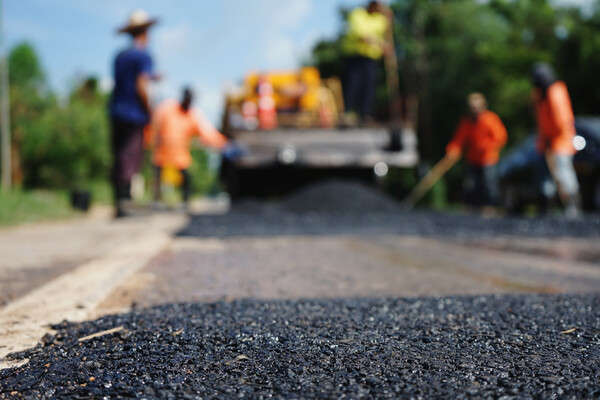Part of America’s new, muscular industrial policy—with about $2 trillion in federal spending over 10 years—is restoring our country’s infrastructure and reshoring its manufacturing.
This endeavor requires a gargantuan number of rocks. Suppliers of cement (made from limestone), and granular aggregates (sand, gravel, and crushed stone) are set to be among the biggest beneficiaries of the $2 trillion investment splurge. The companies that mine common rocks and then turn them into asphalt and concrete for roads, bridges, and buildings are making a fortune.
Who knew that digging up common rocks could be such a profitable business?

It’s Good to Have Rocks in Your Portfolio
As pointed out in a Bloomberg article by Chris Bryant, supposedly dull companies like cement and aggregate suppliers Martin Marietta Materials (MLM), Vulcan Materials (VMC), and Summit Materials (SUM) are going gangbusters. Martin Marietta has gained 34% so far this year and trades at 25 times estimated earnings; Vulcan is valued at more than 30 times this year’s earnings and is 22% up year-to-date.
Bryant explains that these companies should be fairly recession resistant, thanks to booming public infrastructure and non-residential construction. And even though residential construction is weak, that may be about to change. Lower interest rates have sent housing-related stocks soaring in mid-November, with the belief that the Federal Reserve is done raising interest rates spreads.
Even more important in my view is another factor Bryant pointed out…
These firms have a surprising amount of pricing power: Their materials often account for only a small portion of total construction costs, making it easier to raise prices. Many contractors have been forced to accept two price increases per year.
Why do these firms have so much pricing power? Aggregates are produced close to construction sites because their weight makes long-distance transport uneconomical. In addition, there are usually few substitute materials that can be used in construction. Because of this, contractors can’t shop around for a better deal.
Here’s a chart that shows how much certain building materials have gone up in price.
Most of the companies in this sector will do well for many years to come, thanks to the massive infrastructure renaissance underway in the U.S. But I believe that one company stands above the rest to be a huge beneficiary of this spending on infrastructure.
Who Is CRH?
That company is CRH PLC (CRH), which is the largest building materials company in both North America and Europe.
CRH generated $19 billion in sales in the U.S. last year (58% of the overall total). The U.S. accounted for about 75% of the company’s EBITDA (earnings before interest, taxes, depreciation, and amortization).
When CRH last reported earnings on August 24, it showed a 14% increase in first half EBITDA to $2.5 billion. And the company expected full-year profit to increase by a larger than expected 11%, due to higher prices and robust demand for infrastructure and non-residential projects. CRH expects full-year EBITDA of $6.2 billion versus the $5.9 billion expected by analysts.
The company’s EBITDA margin also increased by 90 basis points to 15.6% in the first half of 2023 after the company implemented mid-single to double-digit percentage price increases across the United States and parts of Europe.
CRH CEO Albert Manifold said U.S. government infrastructure spending would lead to a protracted period of growth for the next five to seven years, while the so-called “reshoring” of critical supply chain manufacturing back to the United States and Europe would continue to boost non-residential projects over the same period.
That will translate to the company continuing its run of record profits for at least several years.
Buy CRH Stock
CRH has a $42 billion market capitalization, but there’s huge room for improvement: Even after gaining 45% so far this year, its shares trade at just 14 times estimated earnings, largely because prior to this year, its primary listing in London prior to this year.
CRH is a bargain in comparison to its aforementioned peers—in fact, the stock would need to double to catch up their valuations!
And it may do just that, according to some very smart money managers. Billionaire investors George Soros and Seth Klarman built positions in CRH before it shifted its primary listing to the U.S. Soros Fund Management held 350,000 American depository receipts (ADRs), worth roughly $20 million in CRH at the end of June, while Klarman’s Baupost Group held a nearly 57,000 stake worth $3.15 million, according to regulatory filings compiled by Bloomberg.
And at least 26 hedge funds disclosed new or boosted positions in CRH ADRs in that period. I believe these hedge funds are on to something, with CRH well-positioned for future growth thanks to infrastructure accounting for 40% of its sales in the Americas.
As the largest roadbuilder in North America, CRH is well positioned to commence public infrastructure projects underpinned by the $1.2 trillion Infrastructure Investment and Jobs Act, which is the most transformative public investment program since the 1930s, and will lead to a 50% increase in federal highway funding. There is also $200 billion devoted to water and other infrastructure projects, many of which CRH will help build.
And, 30% of the company’s Americas sales are from U.S. non-residential construction. CRH is a partner in many of the reshoring projects ($200 billion worth) to bring manufacturing back to the U.S.
Add it all up and CRH is a strong buy anywhere in the $55 to $62 range.





